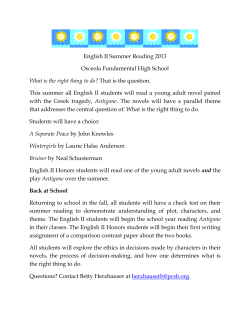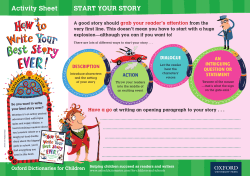
PDF - CLELE JOURNAL
CLELEjournal, Volume 3, Issue 1, 2015 59 ________________________________________________________________________________________ Anna Birketveit and Gweno Williams (Eds.) Literature for the English Classroom. Theory into Practice Bergen: Farbokforlaget, 2013, 260 pp., ISBN: 978-82-450-1382-5 Reviewer Susanne Reichl This volume is a collaboration between researchers, teachers and teacher educators based in Norway and the UK, and brings together ten chapters on genres and skills relevant for the teaching of literature in Norwegian EFL classrooms. There are chapters on picturebooks, fairy tales (both by co-editor Anna Birketveit), creative approaches to drama, teenage novels (both by co-editor Gweno Williams), children's poetry (Turid Husabø), graded readers and extensive reading (Tim Vicary), graphic novels (Hege Emma Rimmereide), film adaptations (Andrew Gordon), the interpretation of novels and short stories (Anniken Telnes Iversen) and academic writing (Barbara Blair). At the risk of sounding shallow, the first thing to note is that, in a world of rather bland academic books, this is an exceptionally beautiful volume, with an appealing cover, an attractive layout and well-chosen colour reproductions from picturebooks and graphic novels. This might well go some way towards what the editors state as their motivation to publish this book, ‘to inspire present and future teachers’ (p. 7) and to provide for ‘teacher and learner choice’ (p. 9), and indeed, the book presents the reader with plenty of recommendations for engaging material for various age and proficiency groups. The book addresses practicing and student teachers, teacher educators and librarians, in the expressed hope that in the future, school libraries in Norway will be more adequately stocked with literature for young readers in English. In their introduction, the editors clarify the Norwegian context by pointing to the significance of literature for children and teenagers and ‘English child culture’ (p. 8) in general at various key stages of the curriculum and, consequently, in Norwegian teacher education. The main aim of the book is to be an accompanying text in Norwegian teacher education and to serve as an invitation, and a motivation, to teachers to supplement the short texts found in coursebooks with longer and more motivating ones. In an afterthought ____________________________________________________________________ Children’s Literature in English Language Education ISSN 2195-‐5212 clelejournal.org CLELEjournal, Volume 3, Issue 1, 2015 60 ________________________________________________________________________________________ to the introduction, the editors express their hope that the suggestions put forward in this volume will be appealing for professionals and students working within a Swedish and Danish educational framework as well. There is no claim made for a possible relevance to teacher education beyond Scandinavia, and indeed all the articles are strongly contextualised within a Norwegian curriculum. However, the principles of using picturebooks, graphic novels and children's poetry at school do transgress national or regional boundaries and some of the suggestions put forward in the volume would also apply to German-speaking countries, even though the curricula and systems might differ. The volume is divided into two sections: Section 1 is a longer section and consists of eight chapters on various genres for young readers and their role in the secondary classroom. Section 2 has only two contributions and focuses on student teachers' own academic skills and the role that literature can assume in this. Formally, the chapters follow a similar structure in that they first explain why the genre they advocate is so useful for the language classroom; secondly, they provide a wealth of material representative of this genre; thirdly, they bring in some ‘theory’ (for a comment on this see below), and finally they sketch the didactic implications and suggestions or case studies. As with any collection of essays, there is a great deal of variety as far as the quality and the realisation of aims in each of these contributions is concerned. All the chapters in Section 1 are convincing in their presentation of their respective genres as perfect teaching material for the EFL classroom: picturebooks, graphic novels, film and drama are all promoted for their multimodality and their promotion of multiliteracies; poetry is praised for encouraging active meaning-making and collaborative interpretation; graded readers are recommended for their motivational potential; drama is endorsed for the powerful context it creates for language production; fairy tales build on learners' schematic knowledge of the structures and characters of fairy tales, and teenage novels have the power to create lifelong readers of fiction. While all this is convincingly put forward, the greatest strength of the volume is its abundance of recommendations of teaching material and the rationale that the contributors offer for their choice of material, as such, it is one of those books that prompts you to go out and buy many of the recommendations. Especially inspiring in that respect is Gweno Williams's chapter on novels for teenage readers, which provides a wonderful selection of ____________________________________________________________________ Children’s Literature in English Language Education ISSN 2195-‐5212 clelejournal.org CLELEjournal, Volume 3, Issue 1, 2015 61 ________________________________________________________________________________________ recent novels by writers such as Malorie Blackman, Louis Sachar, Jacqueline Wilson and Benjamin Zephaniah. Another source of inspiration are the chapters on picturebooks (Anna Birketveit) and on graphic novels (Hege Emma Rimmereide): their selection and presentation of the books is extremely well done. Tim Vicary makes a convincing case for the use of graded readers in an extensive reading environment, but it is a shame that his chapter ends with more than three pages of references of exclusively his own publications and the Oxford Bookworms range. The subtitle of the volume, ‘Theory into Practice’ is not specifically addressed in the introduction, and the theoretical rationale that the editors provide here is rather lightweight as well. The contributors have obviously taken care to include some theory, but the kind of theory and the bridge to practice is not always as clear as it could be. On the one hand, the genres dealt with in the chapters are often theorised in great detail, which makes for very interesting readings on fairy tales, film adaptations and the genre of graphic novels, for example. On the other hand, there are chapters that include no theory at all (such as the one on extensive reading and graded readers). Some contributors make perfunctory references to figures in literature didactics such as Louise Rosenblatt, but fail to go into any detail. What is blatantly missing, especially in a book that is subtitled ‘Theory into Practice’, is the reference to didactics in literature. The field is vast - there has been an impressive amount written about how to teach novels, film, and extensive reading in the classroom, from the UK, the USA and the German-speaking countries, which are frequently published in English. It seems that ‘theory’ is understood by most of the contributors as ‘literary theory’, rather than didactic or pedagogical theory. I would suggest that both need to be brought into such a book. Teacher educators and student teachers alike deserve and need theory to be able to construct their own teaching principles, to be able to select an appropriate method for their materials, and to be able to develop a sense of professionalism for what they are doing. Finally, the didactic recommendations, suggestions for teaching and case studies also vary in their scope and their ability to convince didactically and pedagogically. Birketveit's use of a picturebook version of George and the Dragon (Wormell, 2003/2002) is detailed and convincing (p. 49-50), as is Williams's example of a performance of Lear's The Owl and the Pussycat (p. 199–121) and Rimmereide's suggestion of having learners ____________________________________________________________________ Children’s Literature in English Language Education ISSN 2195-‐5212 clelejournal.org CLELEjournal, Volume 3, Issue 1, 2015 62 ________________________________________________________________________________________ create their own superhero and use apps and online graphic novels (155-158). The ‘didactic reflections’ in other chapters are simply more recommendations of teaching material. The two chapters in Section 2 are somewhat puzzling. The editors point out that they are concerned with the skills that student teachers need to develop during as well as for their studies, but such a skills profile should go well beyond the two sections assembled here and would need a proper rationale. The first (Iversen) reads like an encapsulation of an introductory course in literary analysis, while the second (Blair) focuses on academic writing skills. If the editors wanted to discuss the academic skills that successful student teachers need for their studies, then they might have expanded on the issue, rather than seemingly appending two chapters that are only loosely related to the overall topic. While a new publication on the teaching of literature, even one with such a clear national focus, is certainly welcome, one would wish for a more academic and more principled book. The suggestions and recommendations are wonderfully motivating and very well presented, but the way that some of the contributions deal with the theory available - some by simply ignoring it - does not give the field of teacher education and literature didactics its due as a discipline. Omissions of well-known contributors to the field such as Jane Spiro, Christine Hélot and Sandie Mourão, to mention just a few, is regrettable. In addition, despite its attractive exterior, the book has several editorial slips: it contains formatting mistakes, careless bibliographies (especially in the chapter on picturebooks, where the illustrators are simply not referenced in the bibliography), and unprofessional references - Genette is misspelt (page 27) and his seminal publication, Paratexts, is quoted via a Norwegian publication. Nevertheless, used in combination with a range of books and articles on the pedagogical and didactic theory of teaching literature in the classroom (such as McRae, 1991: Parkinson & Thomas, 2000; Thaler, 2008), this volume, with its remarkable wealth of recommendations, is sure to contribute to providing a bridge between the theory and the practice of teaching literature in the EFL classroom. ____________________________________________________________________ Children’s Literature in English Language Education ISSN 2195-‐5212 clelejournal.org CLELEjournal, Volume 3, Issue 1, 2015 63 ________________________________________________________________________________________ References McRae, J. (1991). Literature with a Small L. London: Macmillan. Parkinson, B. and Thomas, H.R. (2000). Teaching Literature in a Second Language. Edinburgh: Edinburgh University Press. Thaler, E. (2008). Teaching English Literature. Paderborn: Schöningh. Susanne Reichl is Associate Professor at the Department of English and American Studies at the University of Vienna, Austria. Her research interests include Black British and postcolonial studies, British cultural studies, humour, time travel, children's literature, picture books, literature didactics and teacher education. Recent publications include Cognitive Principles, Critical Practice: Reading Literature at University (2009) and the co-edited collection Theory and Practice in Teacher Education. Bridging the Gap (2012). ____________________________________________________________________ Children’s Literature in English Language Education ISSN 2195-‐5212 clelejournal.org
© Copyright 2025









